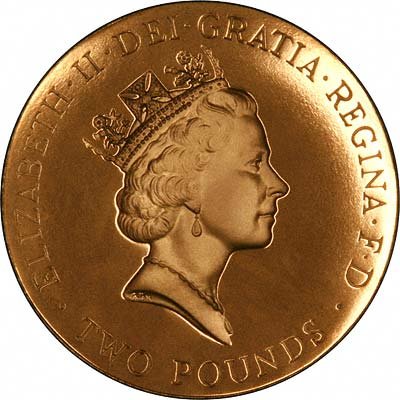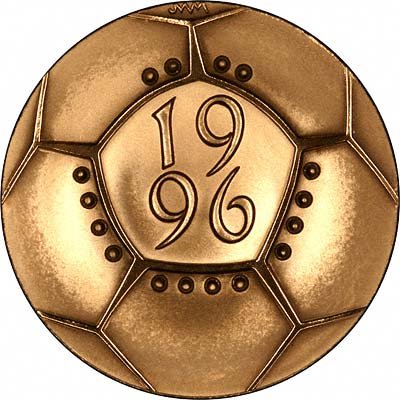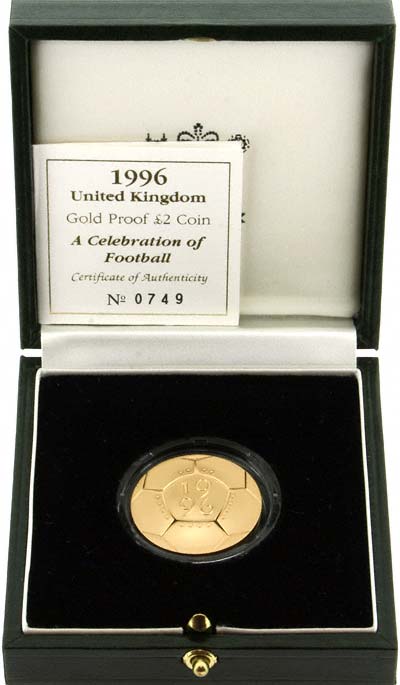1996 Football European Championships Gold Two Pounds
First a few brief notes about the base metal version of this coin.
1996 Two Pounds Coin
Nickel Brass Issues 1986 to 1996
Gold two pounds coins were re-introduced in 1980 for sale to collectors.
The new nickel-brass issues which were produced from 1986 to 1996 were modelled on the previous gold issues, having the same weight and diameter, although thicker.
The entire series of seven different designs in five different years were all commemorative coins, produced largely to appeal to collectors. All are available in different version.
Commemoratives or Consumer Testing?
Although the Royal Mint has stated that the 1997 bi-metal two pounds were the first intended for circulation, ordinary circulation types were released for all seven nickel-brass designs. It is our theory that they were introduced to test public opinion about their popularity, and the practicality of introducing a two pounds denomination for circulation. They were clearly not popular as a circulating coin, being too heavy at a time when most coin denominations were being shrunk. It appears to be part of human nature to resist change, so it was somewhat predictable that the new £2 would not be universally acclaimed. When the smaller five, ten, and fifty pence coins were introduced, they met with criticism as being too small, but the general feeling is that most people would not like to revert to the older heavier designs. In 1997 a new, lighter weight bi-metallic two pound coin was introduced as a circulating coin. Only five of the seven nickel brass series of two pounds were also made available in a gold proof version.
Football World Cup 1996 £2 Coin
"A Celebration of Football"
England - Birthplace of Football
A rudimentary form of football had no doubt been played in many corners of the world since civilisation began but it is with Britain that the origins, development and standardisation of football are most strongly identified.
The game had been played on Shrovetide festivities in England from at least the 1100's, played in the fields between neighbouring rural parishes or in the streets of towns and villages. These early matches were a football free-for-all with perhaps hundreds taking part, the objective being to carry a ball to one end or other of the town or village but because of the lack of rules and resulting "lawlessness" (nothing new there, then!) football was sometimes banned by royal decree. Hard and fast rules were called for and what was perhaps the most important breakthrough came in 1848 when, embracing the best features of their highly individual rules, representatives of Eton, Harrow, Winchester and Rugby met at Trinity College to hammer out the Cambridge Rules. It is from these that the modern game of football has evolved.
By the early 1900's organised tournaments were contested throughout Europe. The British Home International Championships were first played in 1883 and Scandinavian teams fought for the Nordic Cup from 1924. But it was Henri Delauney, the secretary of the French Football Federation, who in the mid-1950's proposed the European Championship. Sadly he died before the first competition got under way in 1958 but, fittingly, the trophy still bears his name.
In 1996, the year that England hosted the tenth European Championship, the Royal Mint struck a special £2 coin in celebration of football. The reverse design gives the impression of a football, an impression accentuated by the unusual dished or bowl-like effect. The special year of 1996 is highlighted amis the familiar pattern of the ball and there are sixteen small rings to symbolise each of the teams who will compete in the finals, held appropriately in the country that is home to football.
Obverse
The Third Portrait
The obverse (head side) is the third major portrait of Queen Elizabeth II, designed by Ralph David Maklouf, FRSA.
It came into use in 1985 and continued until 1996 inclusive, a total of thirteen years.
Reverse Design
The reverse design by John Mills features a gently concave surface representing a football, with the date 1996 in two lines in the centre.
The designers initials, J.M. are visible at the top of the reverse.
Edge
It appears the edge of the gold coin is blank. The milled edge and inscription are on the base metal coin but not the gold proof. The lettering on the base metal version reads:-
TENTH EUROPEAN CHAMPIONSHIP
Technical Specifications
|
Diameter, Millimetres | 28.40
| |
Weight, Grams | 15.98
| |
Alloy (Carats) | 22
| |
Fineness (Millesimal) | 916.6
| |
Actual Gold Content (Grams) | 14.63
| |
Actual Gold Content (Troy Ounces) | 0.4707
| |
Mintage | 2,098 / 2,750*
|
Notes
The issue limit was set at 2,750 but it appears that only 2,098 were sold and produced.
Prices & Availability
All price subject to fluctuation. Please check current pricing and availability before ordering.
| Call to check availability |
You may wish to use our order form.
Postage & Packing
UK Registered Post (Special Delivery) £9 per order
EU Insured Post £10 per order
USA Airmail $10,
Insured Shipping $20
Canada Airmail $15,
Insured Shipping via Fedex $60
Base Metal Issue Mintage
Hardly a week goes by without someone offering to sell us one or more of the base metal version of this coin thinking they have got a gold version. These were struck in nickel-brass, and are therefore a yellow colour. Only a hopelessly over-optimistic person or idiot could confuse these two different metals. We also see base metal versions offered on eBay as gold, but then over half the stuff offered on eBay seems to be stolen, fake, or dubious in some other aspect.
The mintage of 1996 base metal two pounds was 5,141,000.
Fools Gold Two Pound Coins on eBay
We see many of these and other two pounds on eBay described as gold, or not described, but using our photographs of gold proof coins, presumably with the dishonest intention of misleading potential buyers into thinking they can buy a real gold coin cheap. eBay buyers should exercise caution. If something sounds too good to be true, then it probably isn't.
|
|

Obverse of 1996 Football £2 Gold Proof
Two Pounds Index
Other Gold Two Pounds for Sale

Reverse of 1996 Football £2 Gold Proof

1996 Football £2 Gold Proof Presentation Box
Two Pounds Information
|



